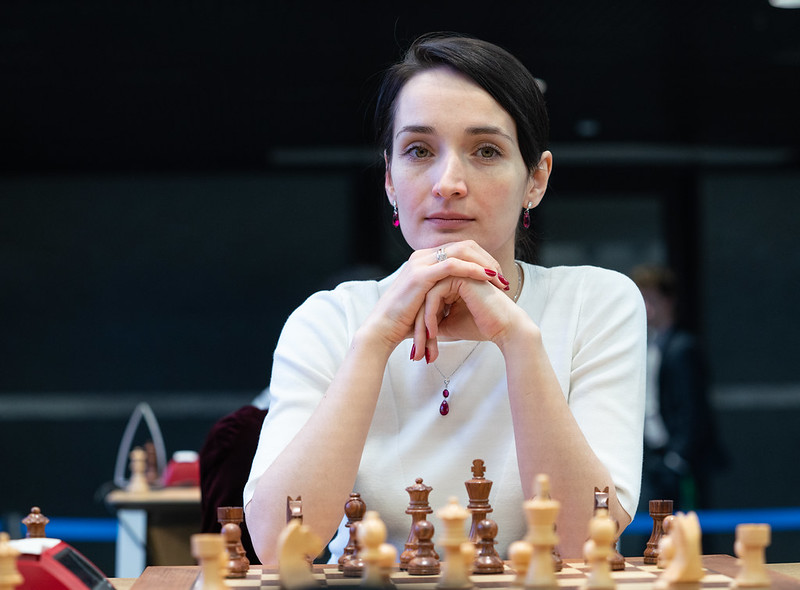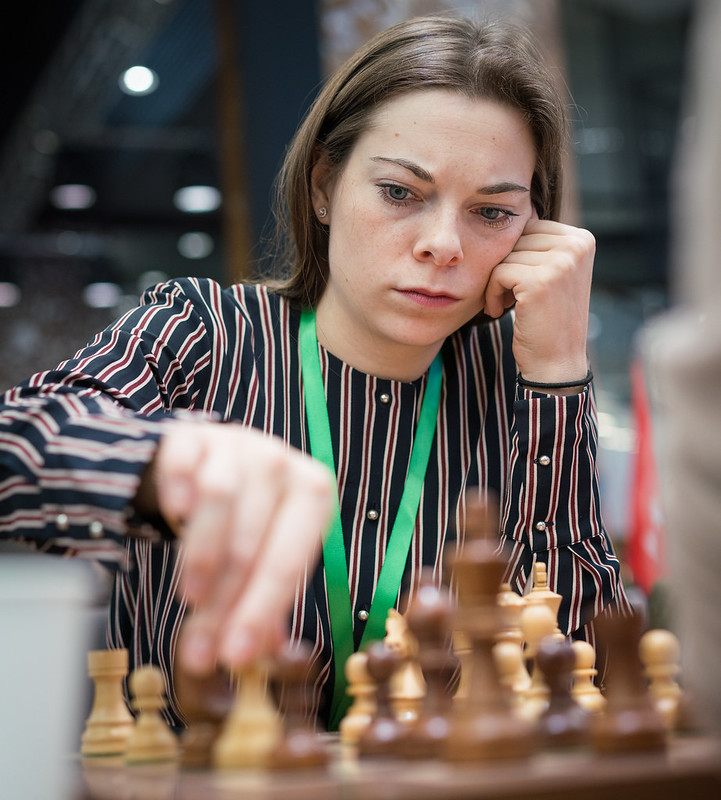


After fifteen rounds of rapid chess (15 minutes plus 10-second increments), the action moved to the blitz format (3 minutes plus 2-second increment). Twenty-one rounds of blitz is the test of stamina that will crown the World Blitz Champion. After the first day and twelve rounds of blitz, we have Magnus Carlsen once again leading the proceedings with a solid score of 10/12. Magnus is half a point ahead of Maxim Matlakov and a full point ahead of Hikaru Nakamura, Daniil Dubov and Ian Nepomniachtchi.
One of the main reasons why the World Blitz Championship is interesting is the fact that World Champion Magnus Carlsen doesn't only play against the elite grandmasters that he is so used to playing in the super tournaments across the year, but also against 2500-2750 rated GMs. Now, these GMs are all talented and strong. Many of them haven't fulfilled their potential because of a lack of opportunities or support. Hence, when they get to play the World Champion they are naturally pumped up.
On the first day of the World Blitz Championship we had several such competent opponents who fought against Magnus — some of them are the best players in the country, some boast a high online blitz rating, some are just supremely talented. Yet, when they face Magnus, they are unable to withstand his play. What's so different about the World Champion? What is it that he does? What's so special about him? Let's try to find out the reasons why Magnus dominated day one of the World Blitz Championship.
The atmosphere in the playing hall of the World Blitz Championship | Photo: Amruta Mokal
The way Magnus sees chess positions is very dynamic. A static, long-term advantage is quickly converted into another without worrying about the fact that he might botch up his edge.
Carlsen has a beautiful knight on c4 and a permanent pawn weakness to attack on c3. He can double the rooks on the c-file, try to get his knight to a square where it could attack the weak pawn and keep manoeuvring about. But what Magnus did requires a lot of faith in your position. He went for the move ...e5!? On one hand you are no longer attached to your superior pawn structure; on the other hand, you say to yourself, this is the right time to launch concrete action. Such decisions, which can be quite tedious for many players, come very naturally to Magnus.
Here's another example:
White has an overwhelming advantage. A natural way to finish off things would be to play ♖e3 and get the rook to h3, when White should be winning. With this method, you keep your central configuration intact (knight on e5 supported by two pawns). However, Carlsen understood the dynamics well and went for f5! This is a very committal move and it also weakens a lot of aspects in White's position, but when you have the superior and active pieces in the position, it makes sense to open it as soon as possible. Within a few moves, Carlsen had reached his opponent's king and it was all over.
And yet another example:
White has a small material edge with his two rooks for a queen. Usually in such positions, it is the rooks that emerge triumphant because there are two white pieces that can attack a weakness, while Black has only one. So how is it that Black is round about even here? It's because of the queenside majority and the weakness of the b2-square. If White loses this pawn, then the c4-pawn becomes very powerful.
After understanding all the facets of the position, guess what move Magnus made? ...c3!?! The b2 weakness is just gone at one shot, but what Black gets in return is activity and the ability for his queen to create chaos. This helped Carlsen not just to maintain equality, but at some point even seize the advantage and win the game!
There are certain systems which are termed as dubious in chess. It seems as if Magnus wants to challenge these pre-conceived notions and try them out any way. After all, it is just blitz! In the first round of the day against Predke, Carlsen played his pet line:
In this position, if White plays the move e5, then Black goes ...♞h5 and continues as if nothing had happened. This line is clearly dubious, but Carlsen has faith in it and believes that these are the perfect weapons in blitz format.
In an all-important round five clash, Carlsen was facing well-known theoretical expert and Vishy Anand's former second Radoslaw Wojtaszek. It's easy to be bogged down when facing such an opponent. Doubts start to creep into your mind. "Should I try the same opening that I tried yesterday?" "Will my opponent have prepared for the same?" Magnus is able to overcome these doubts and play the lines that he has prepared thoroughly.
Baadur Jobava is a creative genius, but against Magnus he was unable to show his magic | Photo: Amruta Mokal
It always feels as if Magnus is a step ahead of you when it comes to openings. And this is the point for just about any opening.
There are two main moves in this position: one is to take on d6 and the other is to play ♘e5. Carlsen knows that ♗xd6 leads to equality and hence played ♘e5.
...♞bd7 looks like the most natural move. However, Carlsen played ...a5. Once again, this move scores better than ...♞bd7 and has the idea of playing ...♞a6. It's ideas like these, which are slightly off beat but have been prepared at home and are played quickly on the board that can truly throw your opponent off balance.
A move like h4 may not be a hundred percent foolproof, however it is a potent weapon for a blitz or rapid game. Ideas like h4 may not be the most dangerous, but they are the weapons that make you feel confident, and Carlsen has a huge arsenal of such weapons. How does he build them up? One can presume that apart from working hard on the openings with his seconds and trainers, he keeps in touch with all the latest games in the world of chess. And this helps him to come up with new ideas in any opening!
Some players just can't bring out the best against you — in Magnus' case, it is Mamedyarov, who is always on the receiving end of Carlsen's brilliant play| Photo: Amruta Mokal
When facing weaker opponents many players do not like to go into sharp lines. Carlsen goes into sharp positions every now and then and almost always comes out on top. His logic is simple — if I am the superior player, then I should be able to calculate a mess better!
...g5!! I give a double exclamation mark to this move not because of its objective value but because Magnus was not shy to take on complications. Objectively, this is a bad move, but in a practical game Salem could not take advantage of it.
When many of the things you do are right, then luck is bound to follow you. As Capablanca put it, "A good chess player is always lucky!" You can see how Magnus' opponents had chances to finish him off in the twelve rounds, but were not able to.
Salem took here on f6, which was fine, but it was much better to play ♕f2! Now the knight cannot be defended and if it moves f7 hangs. All in all, this leads to a lost position for Magnus, and this is not a difficult tactic to spot for a player of Salem Saleh's calibre.
The opening has not gone well for Magnus and he is under some pressure. Black would have done well to play ...c5 here. It opens the c-file, opens the g7-bishop and overall puts a lot of pressure on White's position. Instead. Abdusattorov inexplicably moved his knight to c4 giving up an entire pawn for no good reason.
Wojtaszek automatically recaptured the piece on d5 here with exd5. If he had been more careful he would have spotted the very strong b4!!, which gives a clear advantage.
Magnus has played twenty-seven games since coming to Moscow (15 rapids and 12 blitz), and he has lost only one — this is the one, against Dmitry Andreikin.
| Rk. | Name | Rtg | Pts. | ||
| 1 |
|
GM | Carlsen Magnus | 2865 | 10,0 |
| 2 |
|
GM | Matlakov Maxim | 2720 | 9,5 |
| 3 |
|
GM | Nakamura Hikaru | 2885 | 9,0 |
| 4 |
|
GM | Dubov Daniil | 2736 | 9,0 |
| 5 |
|
GM | Nepomniachtchi Ian | 2826 | 9,0 |
| 6 |
|
GM | Vidit Santosh Gujrathi | 2756 | 8,5 |
| 7 |
|
GM | Artemiev Vladislav | 2793 | 8,5 |
| 8 |
|
GM | Duda Jan-Krzysztof | 2796 | 8,5 |
| 9 |
|
GM | Mamedyarov Shakhriyar | 2706 | 8,5 |
| 10 |
|
GM | Yu Yangyi | 2807 | 8,5 |
| 11 |
|
GM | Quparadze Giga | 2643 | 8,5 |
| 12 |
|
GM | Socko Bartosz | 2557 | 8,0 |
| 13 |
|
GM | Ponkratov Pavel | 2698 | 8,0 |
| 14 |
|
GM | Dreev Aleksey | 2658 | 8,0 |
| 15 |
|
GM | Firouzja Alireza | 2649 | 8,0 |
| 16 |
|
GM | Andreikin Dmitry | 2780 | 8,0 |
| 17 |
|
GM | Petrosyan Manuel | 2483 | 8,0 |
| 18 |
|
GM | Sargissian Gabriel | 2676 | 8,0 |
| 19 |
|
GM | Gareyev Timur | 2533 | 8,0 |
| 20 |
|
GM | Vachier-Lagrave Maxime | 2768 | 8,0 |
Kateryna Lagno is already two times World blitz champion. She won it in 2010 when she was just 21 years old and also in 2018 last year. She is now leading the event with 8.0/9. In the last three rounds, she scored wins against three strong opponents - Gunina, Koneru and Tan Zhongyi.

Kateryna Lagno before the start of round ten | Photo: Maria Emelianova
She is known for her blitz skills — Alexandra Kosteniuk is on 7/9 and in joint second position | Photo: Amruta Mokal
Women's World Rapid Champion Koneru Humpy left off from where she had begun yesterday | Photo: Amruta Mokal

Daria Charochkina, with just a rating of 2212, is playing the best tournament of her life | Photo: Lennart Ootes
Harika started the day with a loss, but recovered to score 6½ points in the remaining 8 games | Photo: Amruta Mokal
| Rk. | Name | Rtg | Pts. | ||
| 1 |
|
GM | Lagno Kateryna | 2606 | 8,0 |
| 2 |
|
GM | Kosteniuk Alexandra | 2521 | 7,0 |
| 3 |
|
GM | Koneru Humpy | 2489 | 7,0 |
| 4 |
|
IM | Charochkina Daria | 2212 | 7,0 |
| 5 |
|
IM | Kashlinskaya Alina | 2282 | 7,0 |
| 6 |
|
GM | Tan Zhongyi | 2480 | 6,5 |
| 7 |
|
IM | Munguntuul Batkhuyag | 2282 | 6,5 |
| 8 |
|
IM | Bodnaruk Anastasia | 2375 | 6,5 |
| 9 |
|
IM | Abdumalik Zhansaya | 2415 | 6,5 |
| 10 |
|
GM | Muzychuk Anna | 2504 | 6,5 |
| 11 |
|
IM | Arabidze Meri | 2412 | 6,5 |
| 12 |
|
GM | Harika Dronavalli | 2445 | 6,5 |
| 13 |
|
GM | Lei Tingjie | 2543 | 6,0 |
| 14 |
|
IM | Paehtz Elisabeth | 2380 | 6,0 |
| 15 |
|
WGM | Voit Daria | 2293 | 6,0 |
| 16 |
|
GM | Gunina Valentina | 2366 | 6,0 |
| 17 |
|
GM | Muzychuk Mariya | 2344 | 6,0 |
| 18 |
|
IM | Gvetadze Sofio | 2202 | 6,0 |
| 19 |
|
IM | Mkrtchian Lilit | 2268 | 6,0 |
| 20 |
|
GM | Dzagnidze Nana | 2432 | 6,0 |
Former World Champion Vladimir Kramnik made a successful appearance at the tournament. After retiring from competitive chess in January 2019, not a lot was expected from Big Vlad. Kramnik managed to play steady chess and after 12 rounds he has collected 8 points. His losses came against Karjakin, Sargissian and Savchenko. Victories were scored against strong players like Donchenko, Chigaev, Iturrizaga, Ivanisevic, Kobalia and others. It will be interesting to see if Kramnik is able to improve on his start or whether he collapses in the second half.
A former World Champion trying his hand at the World Blitz event | Photo: Amruta Mokal

Having an amazing tournament with 9½/12 and in sole second position is Maxim Matlakov | Photo: Lennart Ootes
Hikaru Nakamura, the top seed of the event, had a surprising loss to Alireza Firouzja in round three, but then steadied his boat with five consecutive wins | Photo: Amruta Mokal
That's what blitz does to you! It makes you spectator after your games are over! Carlsen and Nepomniachtchi kibitzing the most exciting game of round two — Bluebaum vs Karjakin | Photo: Amruta Mokal
Vidit Gujrathi lost his last round of the day to Matlakov, but apart from this game his entire day had been an excellent one | Photo: Amruta Mokal
Sometimes the crowd to see the pairings reminds you of your inter-school tournaments — the excitement to see who your opponent is remains intact! | Photo: Amruta Mokal
Volodar Murzin beat several GMs and is gaining 61 Elo points — in the above picture he is on his way to winning an important duel against Eric Hansen | Photo: Amruta Mokal
When coach and student are paired against each other — Nihal and Srinath agreed to a draw! | Photo: Amruta Mokal